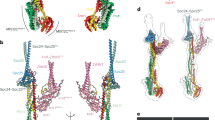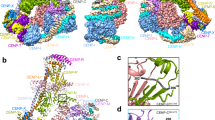Abstract
Kinetochores link centromeric DNA to spindle microtubules and ensure faithful chromosome segregation during mitosis. In point-centromere yeasts, the CBF3 complex Skp1–Ctf13–(Cep3)2–(Ndc10)2 recognizes a conserved centromeric DNA element through contacts made by Cep3 and Ndc10. We describe here the five-domain organization of Kluyveromyces lactis Ndc10 and the structure at 2.8 Å resolution of domains I–II (residues 1–402) bound to DNA. The structure resembles tyrosine DNA recombinases, although it lacks both endonuclease and ligase activities. Structural and biochemical data demonstrate that each subunit of the Ndc10 dimer binds a separate fragment of DNA, suggesting that Ndc10 stabilizes a DNA loop at the centromere. We describe in vitro association experiments showing that specific domains of Ndc10 interact with each of the known inner-kinetochore proteins or protein complexes in budding yeast. We propose that Ndc10 provides a central platform for inner-kinetochore assembly.
This is a preview of subscription content, access via your institution
Access options
Subscribe to this journal
Receive 12 print issues and online access
$189.00 per year
only $15.75 per issue
Buy this article
- Purchase on Springer Link
- Instant access to full article PDF
Prices may be subject to local taxes which are calculated during checkout







Similar content being viewed by others
References
Clarke, L. & Baum, M.P. Functional analysis of a centromere from fission yeast: a role for centromere-specific repeated DNA sequences. Mol. Cell. Biol. 10, 1863–1872 (1990).
Fitzgerald-Hayes, M., Clarke, L. & Carbon, J. Nucleotide sequence comparisons and functional analysis of yeast centromere DNAs. Cell 29, 235–244 (1982).
Murphy, T.D. & Karpen, G.H. Localization of centromere function in a Drosophila minichromosome. Cell 82, 599–609 (1995).
Willard, H.F. Centromeres of mammalian chromosomes. Trends Genet. 6, 410–416 (1990).
Meraldi, P., McAinsh, A.D., Rheinbay, E. & Sorger, P.K. Phylogenetic and structural analysis of centromeric DNA and kinetochore proteins. Genome Biol. 7, R23 (2006).
Joglekar, A.P. et al. Molecular architecture of the kinetochore-microtubule attachment site is conserved between point and regional centromeres. J. Cell Biol. 181, 587–594 (2008).
Cho, U.S. & Harrison, S.C. Recognition of the centromere-specific histone Cse4 by the chaperone Scm3. Proc. Natl. Acad. Sci. USA 108, 9367–9371 (2011).
Hu, H. et al. Structure of a CENP-A-histone H4 heterodimer in complex with chaperone HJURP. Genes Dev. 25, 901–906 (2011).
McAinsh, A.D., Tytell, J.D. & Sorger, P.K. Structure, function, and regulation of budding yeast kinetochores. Annu. Rev. Cell Dev. Biol. 19, 519–539 (2003).
Earnshaw, W.C. & Rothfield, N. Identification of a family of human centromere proteins using autoimmune sera from patients with scleroderma. Chromosoma 91, 313–321 (1985).
Meluh, P.B., Yang, P., Glowczewski, L., Koshland, D. & Smith, M.M. Cse4p is a component of the core centromere of Saccharomyces cerevisiae. Cell 94, 607–613 (1998).
Palmer, D.K., O'Day, K., Wener, M.H., Andrews, B.S. & Margolis, R.L. A 17-kD centromere protein (CENP-A) copurifies with nucleosome core particles and with histones. J. Cell Biol. 104, 805–815 (1987).
Stoler, S., Keith, K.C., Curnick, K.E. & Fitzgerald-Hayes, M. A mutation in CSE4, an essential gene encoding a novel chromatin-associated protein in yeast, causes chromosome nondisjunction and cell cycle arrest at mitosis. Genes Dev. 9, 573–586 (1995).
Brown, M.T. Sequence similarities between the yeast chromosome segregation protein Mif2 and the mammalian centromere protein CENP-C. Gene 160, 111–116 (1995).
Meluh, P.B. & Koshland, D. Evidence that the MIF2 gene of Saccharomyces cerevisiae encodes a centromere protein with homology to the mammalian centromere protein CENP-C. Mol. Biol. Cell 6, 793–807 (1995).
Saitoh, H. et al. CENP-C, an autoantigen in scleroderma, is a component of the human inner kinetochore plate. Cell 70, 115–125 (1992).
Yang, C.H., Tomkiel, J., Saitoh, H., Johnson, D.H. & Earnshaw, W.C. Identification of overlapping DNA-binding and centromere-targeting domains in the human kinetochore protein CENP-C. Mol. Cell. Biol. 16, 3576–3586 (1996).
Clarke, L. & Carbon, J. Isolation of a yeast centromere and construction of functional small circular chromosomes. Nature 287, 504–509 (1980).
Cohen, R.L. et al. Structural and functional dissection of Mif2p, a conserved DNA-binding kinetochore protein. Mol. Biol. Cell 19, 4480–4491 (2008).
Cole, H.A., Howard, B.H. & Clark, D.J. The centromeric nucleosome of budding yeast is perfectly positioned and covers the entire centromere. Proc. Natl. Acad. Sci. USA 108, 12687–12692 (2011).
Mizuguchi, G., Xiao, H., Wisniewski, J., Smith, M.M. & Wu, C. Nonhistone Scm3 and histones CenH3–H4 assemble the core of centromere-specific nucleosomes. Cell 129, 1153–1164 (2007).
Dechassa, M.L. et al. Structure and Scm3-mediated assembly of budding yeast centromeric nucleosomes. Nat. Commun. 2, 313 (2011).
Mellor, J., Rathjen, J., Jiang, W., Barnes, C.A. & Dowell, S.J. DNA binding of CPF1 is required for optimal centromere function but not for maintaining methionine prototrophy in yeast. Nucleic Acids Res. 19, 2961–2969 (1991).
Doheny, K.F. et al. Identification of essential components of the S. cerevisiae kinetochore. Cell 73, 761–774 (1993).
Goh, P.Y. & Kilmartin, J.V. NDC10: a gene involved in chromosome segregation in Saccharomyces cerevisiae. J. Cell Biol. 121, 503–512 (1993).
Hyman, A.A., Middleton, K., Centola, M., Mitchison, T.J. & Carbon, J. Microtubule-motor activity of a yeast centromere-binding protein complex. Nature 359, 533–536 (1992).
Lechner, J. & Carbon, J. A 240 kd multisubunit protein complex, CBF3, is a major component of the budding yeast centromere. Cell 64, 717–725 (1991).
Russell, I.D., Grancell, A.S. & Sorger, P.K. The unstable F-box protein p58-Ctf13 forms the structural core of the CBF3 kinetochore complex. J. Cell Biol. 145, 933–950 (1999).
Strunnikov, A.V., Kingsbury, J. & Koshland, D. CEP3 encodes a centromere protein of Saccharomyces cerevisiae. J. Cell Biol. 128, 749–760 (1995).
Dunleavy, E.M. et al. HJURP is a cell-cycle-dependent maintenance and deposition factor of CENP-A at centromeres. Cell 137, 485–497 (2009).
Foltz, D.R. et al. Centromere-specific assembly of CENP-a nucleosomes is mediated by HJURP. Cell 137, 472–484 (2009).
Kato, T. et al. Activation of Holliday junction recognizing protein involved in the chromosomal stability and immortality of cancer cells. Cancer Res. 67, 8544–8553 (2007).
Sanchez-Pulido, L., Pidoux, A.L., Ponting, C.P. & Allshire, R.C. Common ancestry of the CENP-A chaperones Scm3 and HJURP. Cell 137, 1173–1174 (2009).
Jiang, W., Lechner, J. & Carbon, J. Isolation and characterization of a gene (CBF2) specifying a protein component of the budding yeast kinetochore. J. Cell Biol. 121, 513–519 (1993).
Espelin, C.W., Kaplan, K.B. & Sorger, P.K. Probing the architecture of a simple kinetochore using DNA-protein crosslinking. J. Cell Biol. 139, 1383–1396 (1997).
Espelin, C.W., Simons, K.T., Harrison, S.C. & Sorger, P.K. Binding of the essential Saccharomyces cerevisiae kinetochore protein Ndc10p to CDEII. Mol. Biol. Cell 14, 4557–4568 (2003).
Kaplan, K.B., Hyman, A.A. & Sorger, P.K. Regulating the yeast kinetochore by ubiquitin-dependent degradation and Skp1p-mediated phosphorylation. Cell 91, 491–500 (1997).
Bouck, D.C. & Bloom, K.S. The kinetochore protein Ndc10p is required for spindle stability and cytokinesis in yeast. Proc. Natl. Acad. Sci. USA 102, 5408–5413 (2005).
Yoon, H.J. & Carbon, J. Participation of Bir1p, a member of the inhibitor of apoptosis family, in yeast chromosome segregation events. Proc. Natl. Acad. Sci. USA 96, 13208–13213 (1999).
Heus, J.J., Zonneveld, B.J., Steensma, H.Y. & Van den Berg, J.A. Centromeric DNA of Kluyveromyces lactis. Curr. Genet. 18, 517–522 (1990).
Heus, J.J., Zonneveld, B.J., de Steensma, H.Y. & van den Berg, J.A. The consensus sequence of Kluyveromyces lactis centromeres shows homology to functional centromeric DNA from Saccharomyces cerevisiae. Mol. Gen. Genet. 236, 355–362 (1993).
Sorger, P.K. et al. Two genes required for the binding of an essential Saccharomyces cerevisiae kinetochore complex to DNA. Proc. Natl. Acad. Sci. USA 92, 12026–12030 (1995).
Bellizzi, J.J., III, Sorger, P.K. & Harrison, S.C. Crystal structure of the yeast inner kinetochore subunit Cep3p. Structure 15, 1422–1430 (2007).
Holm, L., Kaariainen, S., Wilton, C. & Plewczynski, D. Using Dali for structural comparison of proteins. Curr. Protoc. Bioinformatics Chapter 5, Unit 5.5 (2006).
Krissinel, E. & Henrick, K. Secondary-structure matching (SSM), a new tool for fast protein structure alignment in three dimensions. Acta Crystallogr. D Biol. Crystallogr. 60, 2256–2268 (2004).
Conway, A.B., Chen, Y. & Rice, P.A. Structural plasticity of the Flp-Holliday junction complex. J. Mol. Biol. 326, 425–434 (2003).
Guo, F., Gopaul, D.N. & van Duyne, G.D. Structure of Cre recombinase complexed with DNA in a site-specific recombination synapse. Nature 389, 40–46 (1997).
Altschul, S.F. et al. Gapped BLAST and PSI-BLAST: a new generation of protein database search programs. Nucleic Acids Res. 25, 3389–3402 (1997).
Goodwin, T.J., Butler, M.I. & Poulter, R.T. Cryptons: a group of tyrosine-recombinase-encoding DNA transposons from pathogenic fungi. Microbiology 149, 3099–3109 (2003).
Stoyan, T. & Carbon, J. Inner kinetochore of the pathogenic yeast Candida glabrata. Eukaryot. Cell 3, 1154–1163 (2004).
Camahort, R. et al. Scm3 is essential to recruit the histone h3 variant cse4 to centromeres and to maintain a functional kinetochore. Mol. Cell 26, 853–865 (2007).
Aravind, L., Iyer, L.M. & Wu, C. Domain architectures of the Scm3p protein provide insights into centromere function and evolution. Cell Cycle 6, 2511–2515 (2007).
Yeh, E. et al. Pericentric chromatin is organized into an intramolecular loop in mitosis. Curr. Biol. 18, 81–90 (2008).
Adams, P.D. et al. PHENIX: a comprehensive Python-based system for macromolecular structure solution. Acta Crystallogr. D Biol. Crystallogr. 66, 213–221 (2010).
Acknowledgements
We thank the staff at the Advanced Photon Source NE-CAT beamlines for advice and assistance with data collection and interpretation, D. King of the Howard Hughes Medical Institute Mass Spectrometry Facility, University of California, Berkeley, for mass spectrometry, and K. Corbett and P. Sorger for helpful discussions. This research was supported by the Howard Hughes Medical Institute.
Author information
Authors and Affiliations
Contributions
U.-S.C. designed and conducted experiments, determined and refined the structures, analyzed data and wrote the manuscript; S.C.H directed the project, analyzed data and wrote the manuscript.
Corresponding author
Ethics declarations
Competing interests
The authors declare no competing financial interests.
Supplementary information
Supplementary Text and Figures
Supplementary Figures 1–8 and Supplementary Methods (PDF 9848 kb)
Rights and permissions
About this article
Cite this article
Cho, US., Harrison, S. Ndc10 is a platform for inner kinetochore assembly in budding yeast. Nat Struct Mol Biol 19, 48–55 (2012). https://doi.org/10.1038/nsmb.2178
Received:
Accepted:
Published:
Issue Date:
DOI: https://doi.org/10.1038/nsmb.2178
This article is cited by
-
Structural and dynamic mechanisms of CBF3-guided centromeric nucleosome formation
Nature Communications (2021)
-
Backbone and side-chain resonance assignments of centromeric protein Scm3 from Saccharomyces cerevisiae
Biomolecular NMR Assignments (2019)
-
Architecture of the CBF3–centromere complex of the budding yeast kinetochore
Nature Structural & Molecular Biology (2018)
-
Tension sensing by Aurora B kinase is independent of survivin-based centromere localization
Nature (2013)
-
The CENP-A nucleosome: a dynamic structure and role at the centromere
Chromosome Research (2012)



